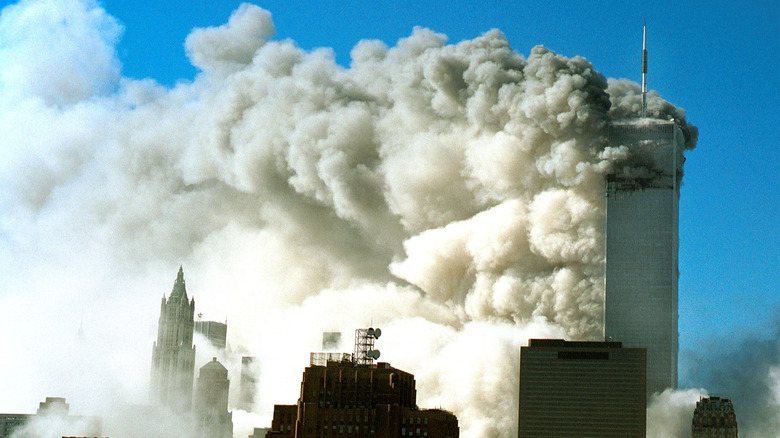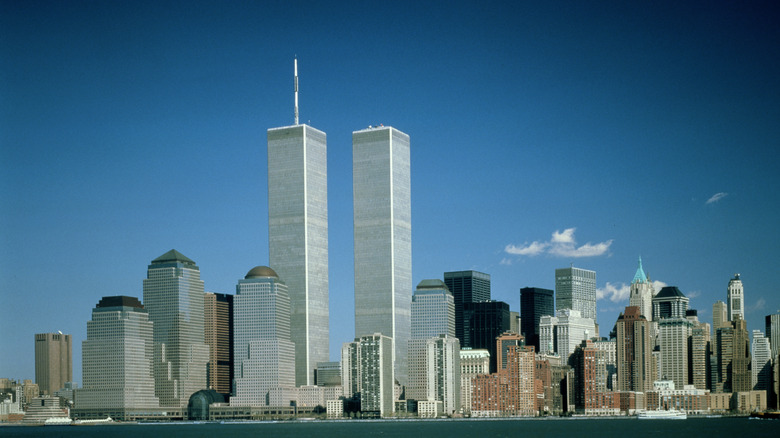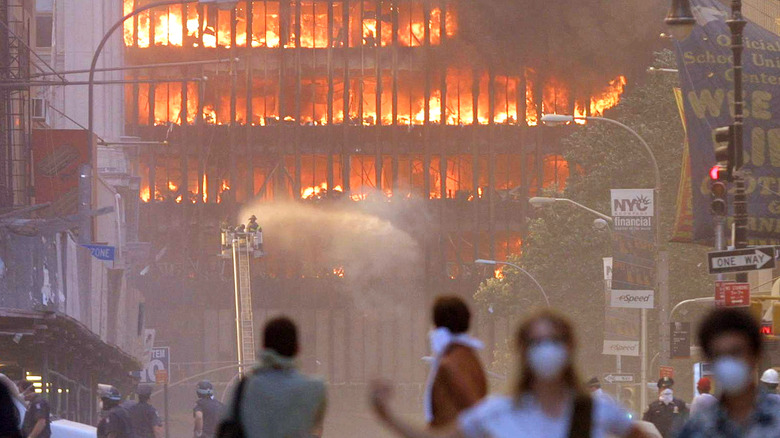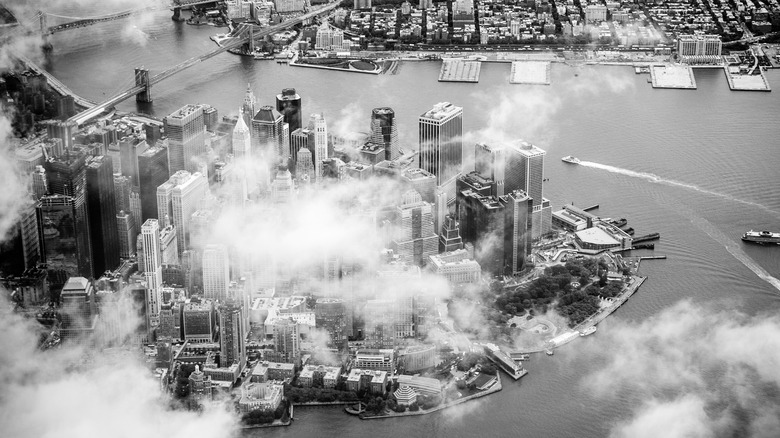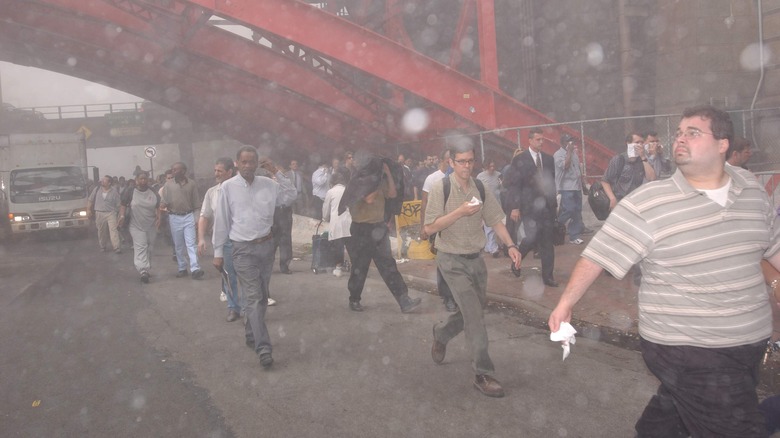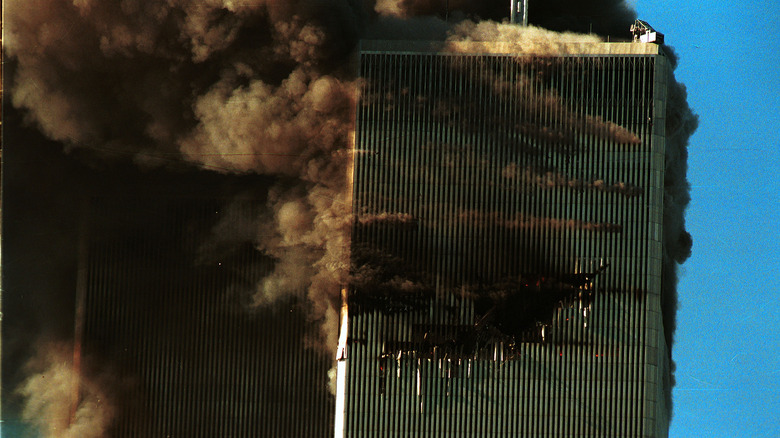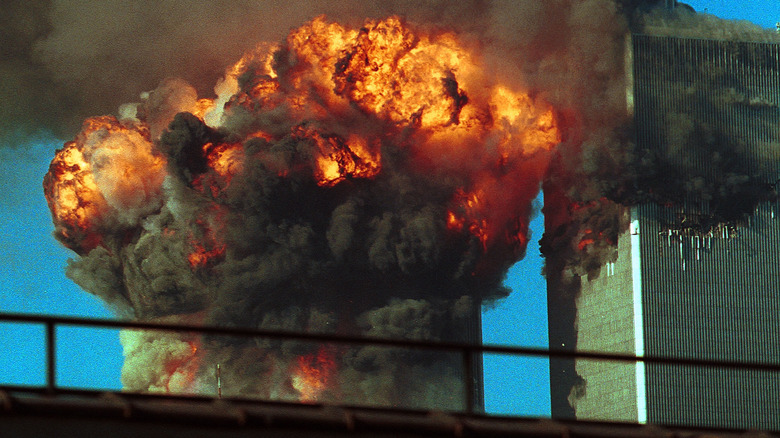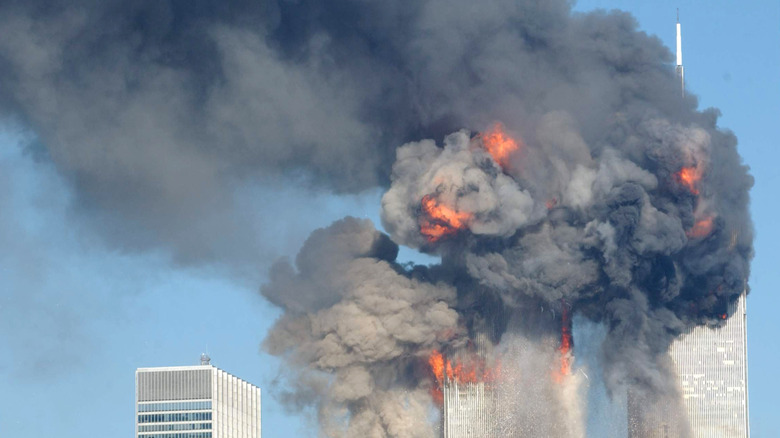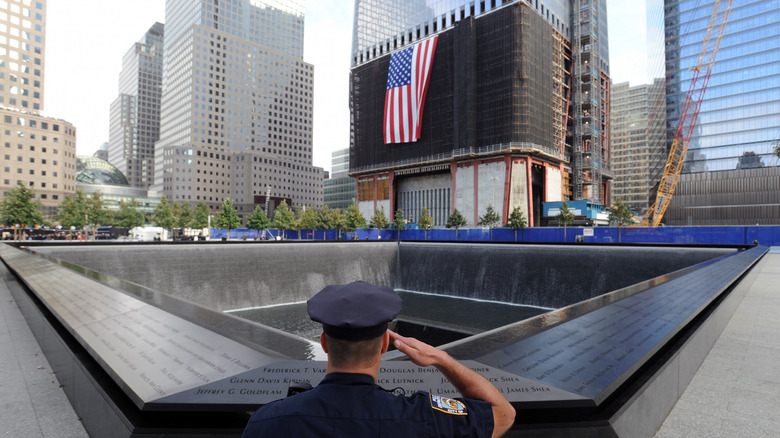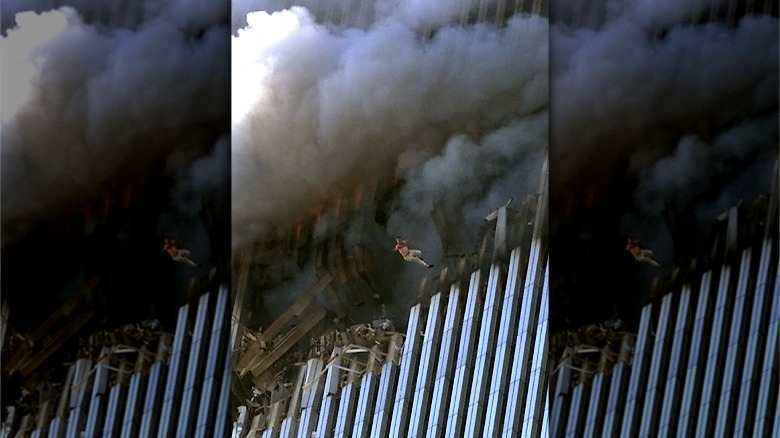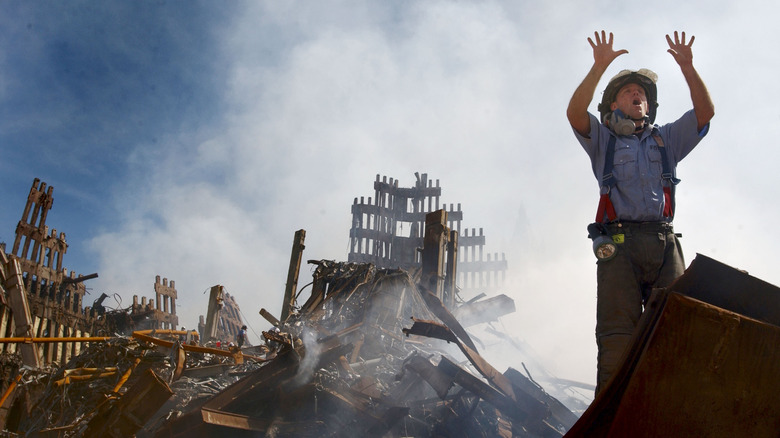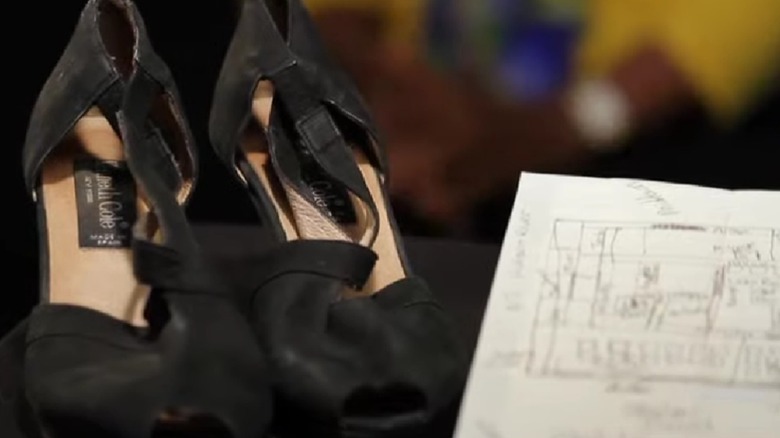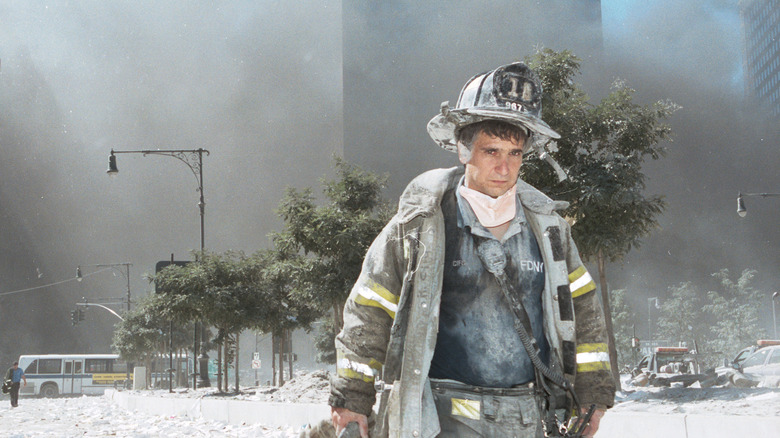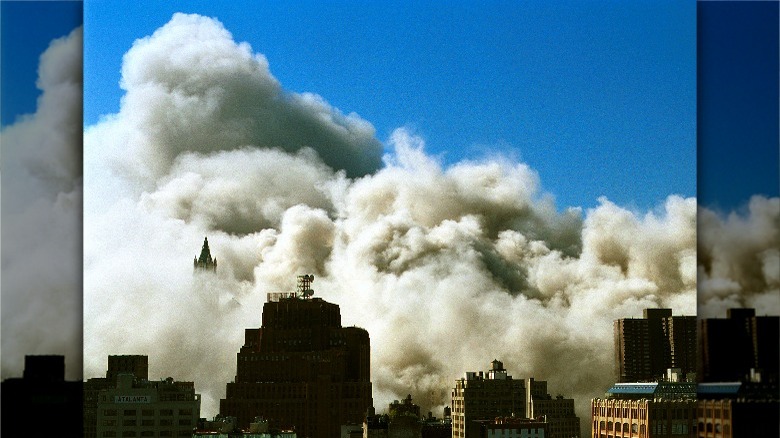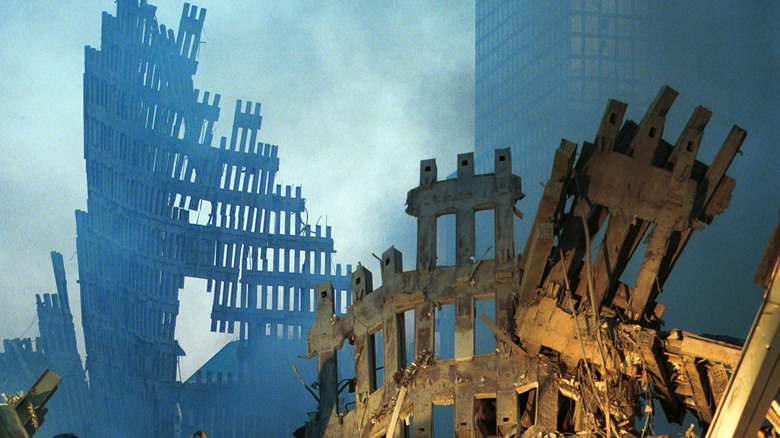What It Was Like Inside The World Trade Center When 9/11 Happened
The September 11 attacks are an event that's been indelibly burned into the collective memory of plenty of people, and for many different reasons. Even decades later, most Americans can tell you where they were when they heard the news; whether that location was New York or not, people can remember how they saw the footage captured of black smoke billowing from the World Trade Center. Not only that, 9/11 is something that not only transcended physical space back in 2001, but its impacts have transcended time. Those who are too young to have lived through it or recall those events still know the lasting effects, whether that be the perception of terror or the airport security measures it led to.
All that said, there are very specific stories from that day that most people are lucky to have never experienced: the stories of people who were inside the World Trade Center (or the Pentagon, for that matter) on the morning of September 11, 2001. The stories of people who survived the attacks that killed thousands of others. The stories and details are tragic, above all else, so it's worth saying to read on at your own discretion.
It seemed like a normal day
The thing with tragedy is that sometimes, there's just no way to see it coming, no indication of anything bad. The September 11 attacks are no exception.
According to ABC News, many survivors of the attack have described that day as perfectly normal. Florence Jones — one of the last few people to escape the South Tower of the World Trade Center — even added that it was actually a particularly beautiful day, characterized by perfectly blue skies that had people in high spirits. Brian Clark has described the very same thing (via PBS); in his own words, "That particular day was more or less flawless weather — beautiful day, blue sky ... We had an unseasonably warm fall, and I'm assuming that day was equally pleasant." Clark added that the morning was uneventful, a completely normal day at the office with the usual chores and responsibilities, nothing standing out at all in his memory.
Very similar recollections were shared by plenty of others in the World Trade Center on that day. Lauren Manning was actually in really high spirits on that day, excited about the work that she was doing, and glad to do it in a space she called "a place of peace" (via CBC). Theresa Marino Leone (via Nieman Foundation) said that she had gone to work without eating breakfast and was in the middle of grabbing some food from the cafeteria while chatting with some coworkers. But in the middle of those mundane, pleasant days, everything suddenly changed.
Fire and burning gasoline was everywhere
When you see images from 9/11, there are more than a few that show the level to which the towers were burning, before their eventual collapse. But the situation as it was experienced by those who were inside was far scarier than photos can really communicate.
When the North Tower was hit, Brian Clark realized something was wrong when he caught a glare out of the corner of his eye, only to suddenly realize that the open air just outside the window of his South Tower office wasn't quite so open anymore. It was filled with flames that he later learned was burning jet fuel. Vinny Borst was inside that very tower, though; as he fled from the 82nd floor, he came face to face with corridors quite literally filled with flames (via CBS News).
However, Lauren Manning might be one of the survivors most affected by the ensuing fire. She'd just gotten to the North Tower when the crash sent a column of fire down the elevator shaft and directly into the lobby. She recalled, "There was this incredibly loud, piercing, whistling sound and an instant later I was engulfed in flames," and ran outside, dropping to the ground to try and douse the fire, as per Sky News. Over 80% of her body was burned, and she was put into a medically induced coma for three months. Her survival was nothing short of a miracle, but recovery was still a decade-long process.
There was a lot of confusion
The 9/11 attacks have persisted in plenty of peoples' memories, and just about everyone knows at least the basic details, or maybe the images of the World Trade Center on the cusp of collapse. But in the moment, things were very different, especially for those in the towers.
Bob Swierupski explained to the Department of Homeland Security (DHS) that those on the lower levels (like the fourth floor, where he was working) of the World Trade Center really couldn't tell what happened. He felt the rumbling, and a coworker saw the debris fall past a window, but that's all he knew. The story was a complete mystery until he evacuated and stepped outside for the first time, only to be greeted by the sight of a plane in the side of his building. Joe Dittmar had a similar experience, but from the very top of the South Tower. As he told 9 News, "We were in an internal conference room, so there were four walls with no windows and one door. So we didn't see anything. We didn't feel anything. We didn't hear anything. We just saw this flicker of lights."
The confusion led to plenty of guesses as to what was happening. David Paventi told Fox News that he thought it was an earthquake and even responded as such by getting under a table, while Theresa Marino Leone wrote (via Nieman Foundation) that without phone service, she'd thought it was some kind of helicopter accident.
But there wasn't as much panic as you'd expect
The persistent images of 9/11 are tragic, to say the least, and plenty of survivors had to overcome harrowing odds to live and tell their tales. From an outside perspective, it would be reasonable to assume that there was a lot of panic in both the South and North Towers on that day. Perhaps surprisingly, though, some accounts from those who escaped the World Trade Center seem to paint a different story.
Bob Swierupski said that at least among the vague confusion on the lower floors of the World Trade Center, there was relatively little panic in the beginning; it had been bombed back in 1993, and employees had been trained to evacuate if they felt unsafe. Of course, that didn't mean there wasn't any unease, though. Theresa Marino Leone mentioned the regular fire drills in her own account of the events and added that, despite the practice, it's very different when it's no longer a drill. She and those around her weren't exactly sure of what to do, but once they started heading down the narrow staircases, "there was no pushing or panic or people getting trampled."
Perhaps due to the confusion — or something else entirely — Leone's experience wasn't an isolated one. David Paventi remembered the complete silence in the stairwell he found himself in, and Kevin Danni said that his descent down the stairs was marked by a kind of "orderly chaos," as per Occidental College.
Some people didn't think there was much of a problem
Across almost every account of the 9/11 attacks from within the World Trade Center, survivors seemed to know that something was wrong, even if they weren't sure of the details. But without those specific details, not everyone inside necessarily thought that they were in all that much danger, inconceivable as that might seem in hindsight.
From his office high in the South Tower, Brian Clark could see the North Tower after it was hit, but when those on his floor realized their tower was still intact, many began to relax. An announcement over the PA system only reinforced that feeling: "Building Two is secure. There is no need to evacuate Building Two. If you are in the midst of evacuation, you may return to your office."
The smaller interactions from throughout the World Trade Center are rather similar in sentiment to that PA announcement. Bob Swierupski recounted that while he and his coworkers were heading toward their evacuation point, one of them had a sudden realization: "I have to turn off the coffee pot." And Joe Dittmar remembers a general sense of annoyance that spread through his meeting room upon being told that he (and those he was meeting with) would have to evacuate: "Everybody ... pretty much had the same reaction ... to call somebody to moan and groan about the fact we couldn't have our meeting."
There was a lot of water throughout the towers
The impact of the two planes with the North and South Towers is something that's often associated with a lot of fire, smoke, oil, and jet fuel. Understandably so, especially considering how many survivors have talked about fireballs suddenly erupting. But it might come as a bit of a surprise that there was a concerning amount of water flooding many different floors of the towers.
David Paventi recalled that the lobby was a mess, and that amid the emergency lights and broken glass, there were also puddles of water on the floor. He didn't say much beyond that, but Theresa Marino Leone added more to that picture. Around the 10th floor, she began to notice that there was water running down the walls, and as she continued to descend, it only got worse. Only a couple of floors later, the water was well past everyone's ankles — about 6 inches deep. By the ground floor, she described the journey by saying, "Water was pouring down on us — like walking in a soaking rainstorm, but inside."
The explanation most likely comes from Brian Clark's version of events. Apparently, the sprinkler system had turned on, but it wasn't quite working right. Whatever the issue was, he noted, "There was water sloshing down the stairways." And this wasn't an issue unique to the lower floors of the building; rather, the flooded staircase Clark was faced with was around the 81st floor.
Some moments felt like a disaster film
In many accounts of the attack on the World Trade Center, there are, perhaps, surprisingly few accounts that mention panic. All the same, that doesn't mean that the situation wasn't terrifying in its own ways, even for those who survived relatively unscathed, at least speaking physically. Some of the descriptions are truly visceral and terrifying.
David Paventi explicitly likened the destruction to something you'd see in an action movie: "Looking outside, it looked like a scene from 'Die Hard.'" Given the shattered windows and glow of emergency lights, it's a reasonable comparison. Vinny Borst made a very similar comment to CBS News, saying, "It's like a scene out of 'The Towering Inferno.'"
Joe Dittmar went further into the details he experienced, and his descriptions only further the justification behind comparing the events of 9/11 to an action, horror, or disaster film. He recalled being inside a fire stairwell when the entire building began to shake, except that there was nothing natural about the shaking. As a result of the shaking, he went on to describe how everything began to quite literally fall apart: "The concrete starts spidering out and the handrails are breaking away from the wall and the steps are like waves in the ocean undulating underneath your feet ... Maybe it was seconds, maybe a minute and then it finally settles."
Survivors remember those who died
Between the attacks on the World Trade Center, the Pentagon, and the third plane that crashed in a field in Pennsylvania, the September 11 attacks resulted in nearly 3,000 casualties and a large number of injuries. Of course, anyone who survived the attacks has memories of those who didn't, but those who just barely made it out of the World Trade Center have recalled some visceral last moments with their friends and coworkers.
The South Tower was hit on its 78th floor, and Florence Jones told ABC News that she was just one floor below, on the 77th floor at that moment. As if that wasn't harrowing enough, she had just been up on the 78th floor mere moments earlier, telling her coworkers there that they should probably evacuate, given that they already knew the North Tower had been hit. Not only did she narrowly escape death, but she explicitly mentioned that she suddenly realized all of the people she had just talked to minutes before were just gone.
Joe Dittmar told a similar story from his descent down the South Tower, explaining that he happened to run into a coworker on the way. Both of them intended to get out of the building, but the other man said he wanted to take a small detour before doing so: the bathroom. Talking about it later, Dittmar remarked, "That simple decision to use the restroom — that two-and-a-half minute or so delay in his exiting — cost him his life that day."
Those in the South Tower could witness everything
Survivors who escaped from the World Trade Center's South Tower all have their own stories of tragedy and narrow escapes, but beyond their own personal tales, they also had to bear witness to the destruction of the North Tower.
Joe Dittmar told 9 News that he couldn't see anything while descending down 15 flights of stairs, but as soon as he approached a window, he was met with a terrifying sight: "I remember being able to see through that smoke, through that fire, into the huge black holes in the building and seeing pieces of the fuselage of a large plane." In short, he "experienced the worst 30 or 40 seconds of [his] life."
Brian Clark recounted a very similar experience during the calm before the storm — the brief window of time when he and his coworkers thought the South Tower was safe. He knew that the sight of the North Tower burning was visible through the windows on the north side of his building, but he couldn't say firsthand what was visible. According to him, "I just didn't want that image burned in my brain, and I'm forever grateful that I didn't go and take in that sight." The people around him couldn't help but look, though — at least, for a while. A woman in the office was watching until she realized that people were jumping from the windows, and she turned to Clark for comfort, tears in her eyes.
Acts of heroism
Stories of heroic acts from the 9/11 attacks abound, and they're honored to this day. But such stories aren't confined to only first responders.
Brian Clark's story includes many instances of civilians being heroes, doing everything they could to try and help as many people escape as possible. Clark himself was quite a hero in his own right; in the middle of smoke and debris that had begun to choke his friend, Clark heard the cries for help of a man, Stanley Praimnath, who was buried in debris. Despite a near-blinding level of white dust, he found Praimnath and cleared away the debris before telling him he had to jump past the last barrier. "Stanley jumped, and I got him by the collar or the shoulder," he recalled. "He said later that I just pulled him up like Superman. I don't remember having this extraordinary strength, but he says it really did happen that way." Others Clark ran into were doing much the same thing, stopping when they found people who needed help and calling out for more aid, which was then answered when their coworkers headed back up the stairs to do whatever they could, even if they could have easily headed for an escape instead.
But survivors don't have to be compared to comic book superheroes for their bravery and kindness to have mattered. Florence Jones remembered the support she and her colleagues gave each other, holding hands and guiding one another safely through stairwells filled with smoke.
Many women went without their shoes
On one hand, this might seem like a strange detail to point out, especially in the midst of the horrors that took place on September 11, 2001. But it's a detail that comes up in quite a few accounts told by survivors of the attacks on the World Trade Center.
In fact, Theresa Marino Leone's story is even titled "Rosary Beads and Sensible Shoes" (via Nieman Foundation). For Leone, she was glad that she was wearing flats that day, because she was able to keep them on during the long walk down the tower — and that served her well when the water suddenly started rising. The same couldn't be said of many other women, however, who had to be carried by firefighters due to the shattered glass on the floor. Leone could only be glad in that moment, saying, "Thank God I had on my sensible shoes."
That said, there are plenty of stories of women who didn't have such sensible shoes with them on that day. Florence Jones told ABC News that her boss was worried that she might trip and fall as a result of her shoes (pictured above) — combined with the smoky stairwell and shaking building — so he held onto them the entire way down. Joe Dittmar made a similar observation, having found plenty of high-heeled shoes and personal belongings abandoned throughout the tower and commenting that there must have been "a lot of barefooted women that day in the tower."
Emergency responders and their bravery
The New York Fire Department lost 343 members on September 11, and an equal number died of long-term illnesses caused by their work in the two decades after, with thousands more emergency responders still suffering from various forms of related health issues. That bravery is something to be memorialized for the foreseeable future.
The recognition of that bravery is hardly something that needed to develop over time, as survivors of the attack on the World Trade Center have often made mention of the firefighters they saw during their evacuation. Theresa Marino Leone recalled passing by some of them multiple times on the stairwell alone. In one case, they were carrying victims of severe burns, and in another, she felt on the verge of fainting, until a group simply offered her a sip of water that she desperately needed. A small detail that she followed with the realization that those men probably died. Joe Dittmar commented on their bravery as well, saying, "The looks in their eyes told the story ... they knew that they were going up those steps to fight a fire that they couldn't beat ... I don't know how you can be that brave."
Perhaps the most haunting, however, is David Paventi's account; a firefighter happened to pause next to him and comment, "I get to do all this for 35,000 a year" (via Fox News). Something about that brief moment has stuck with him all those years since.
Miraculous stories of survival
There are so many stories of both survival and tragedy that come from the attack on the World Trade Center. One of the most incredible, though, is the story of Josephine Harris.
In short, a group of firefighters and cops happened to find Harris on the 22nd floor of the North Tower, too exhausted to continue down the stairwell in the middle of the building, per USA Today (via The Herald). Of course, they took her with them, carrying her the entire way, but as the group began to approach the bottom floor, the tower shook, and a hurricane-like gust of wind rushed down the stairwell. The shaking and wind was the North Tower collapsing, but somehow, Harris and 13 of the others who were carrying her had somehow survived, and with only minor injuries. Not everyone survived the collapse, to be fair, but those 14 were all situated between the lobby and sixth floor, which just so happened to be especially sound, structurally speaking. The large, open atrium at the center of the bottom six floors was perfectly empty, and the reinforced base of the seventh floor proved strong enough to force any debris to fall into that empty space. Or, as one of the firefighters later explained it, the North Tower "peeled away like a banana" (via The New York Times).
In the years following, Harris and the firefighters remained close, debating who had saved who. Was she alive only because of them, or had they survived because they paused to do so?
Escaping from the World Trade Center wasn't the end
Stories of surviving the attacks on the World Trade Center might seem like they ended once people reached the doors of the towers, but that's not quite the truth.
Multiple accounts mention the danger of falling debris. Brian Clark recalled getting to one of the exits, only to be stopped by first responders who told him that crossing the street would be dangerous due to that debris. When Clark asked if he should look for the debris to try and avoid it, the response he received was simply, "Well, I wouldn't. Just go for it." David Paventi was given very similar advice when he finally arrived in the courtyard: "Don't look, just run." Meanwhile, Joe Dittmar wasn't given words of wisdom in that vein, because he was ushered into underground tunnels instead. There was too much danger by not only the falling debris but also, according to Dittmar, the bodies of those who had jumped.
Then there are those like Vinny Borst, who were caught in the collapse. Borst wasn't hit by large pieces of debris, but he did exit the North Tower right as the South Tower fell. Dark soot flew into his face, blinding him, and he described the experience as being "like bags of concrete coming down on the top of your head." He managed to claw his way out of the dust cloud, not even realizing at the time what had happened.
